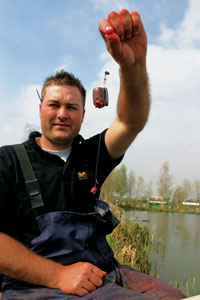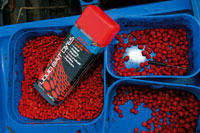Welsh international Lee Edwards’ no-nonsense pellet feeder method is simple but deadly. All you need is an island within casting distance, and red pellets!
The Method
The pellet feeder is a devastatingly simple method, and works on any venue that has an island or feature within casting range. I like to start on the pellet feeder as soon as the whistle goes, even before cupping in bait on any other line. This lets me take command of the far bank from the start, and it’s not uncommon to be netting a fish while everyone else is still cupping in bait!
Accuracy is vital. It is essential to clip up and keep putting the feeder down exactly the same hole every cast. If a cast lands a couple of feet short of the island I always reel in and recast rather than leaving it where it has landed. Being disciplined in this way will definitely put more fish in the net.
I like to point my rod almost straight in front of me on the rest, rather than at an angle to one side. This helps greatly with accuracy, and bites from carp and F1s still register on the quivertip well.
The Bait
I prefer to use Fin Perfect 4mm feed pellets because I know how they react when dampened down. The pellets don’t need to be completely soaked; I like to soak them for just two minutes before draining them over a riddle and placing in a bait tub. Wetting them for just a short period ensures they hold inside the feeder well but still empty after casting. A short soak also ensures they don’t go mushy and stick to the bottom of the bait tub.
 |
| Lee prefers 4mm Fin Perfect feed pellets. |
For an added kick I like to dye my feed and hook pellets red. I use sonubaits.com’s red liquid bait dye but, as it is so concentrated, I dilute it 50/50 with water and spray it from an atomiser. I simply squirt this on my already dampened pellets, place a lid on the tub and agitate them to disperse the dye.
My hook bait is normally a Fin Perfect 6mm expander or the new 6mm S-Pellets, again dyed red. The normal expanders are best hair rigged against the grain of the fibres, which makes them stay on the hook better. The rubbery consistency of the S-Pellets is more suited to when I need to really punch the feeder out.
Interestingly, you can make S-Pellets more buoyant by squeezing some of the oil out of them before baiting up. I also like to add strawberry flavouring to some of my hookers to make them stand out.
The Rigs
I use a Preston CarbonActive 12ft Feeder rod for this game, matched to a Daiwa TD-R2058 reel loaded with 5lb Korum line. For longer casts I will step up to the larger, 3012 reel.
My hooklength is 12 inches of 0.19mm Preston Fluorocarbon. After much experimentation, this seems to offer me the best strength and abrasion resistance, which is important when you are fishing towards reeds and other potential snags. I believe the increased stiffness also helps with hooking fish with a hair-rigged bait.
My hook is a size 18 PR36, finished off with a hair rig and Quickstop, which makes baiting up extremely fast.
Finally, the feeder is a standard 20g Preston open-ended version. Using a relatively heavy lead helps with casting accuracy and also gives the fish something to bolt against. The feeder is free running and stopped in place with a quick-change bead.
The Rewards
The pellet feeder is so simple and effective that I cannot believe more people don’t use it. In a short session for the cameras I’ve netted a healthy 40lb bag of fish, predominantly big F1s, up to 11/2lb, with a smattering of tench, crucians and larger carp to 6lb. It’s been a busy day but accurate casting has ensured a bite almost every single cast. As expected, the more bait that went in the bigger the fish got. By the end the bites were sometimes coming before the feeder had even settled. Any method that brings red-hot action like this has to be worth a second look!






